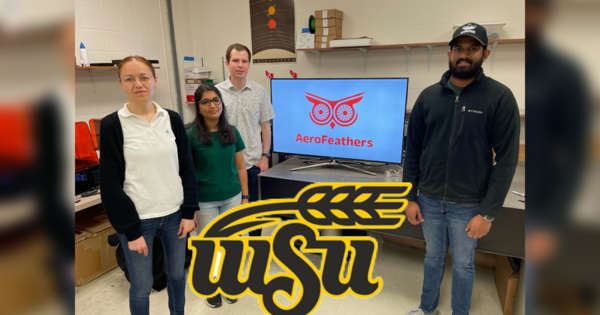[ad_1]
© Provided by KSNW Wichita
WICHITA, Kan. (KSNW) — Owls dive head-first to attack their prey. Their silent, stealth-like wings allow them to swoosh to the ground undetected.
A group of Wichita State University (WSU) students – made up mostly of aerospace engineering graduate students – is trying to replicate the owl’s uniquely designed wings to create silent drones for NASA’s University Student Research Challenge.
They turned to nature to try to find a possible solution.
Drones have become a necessary tool in the TV news-gathering business. They’re also used for network sports events, surveillance, surveying, real estate photography, and much more.
One downside to drones is they’re noisy.
“One major problem that we have in aerospace is making drones quieter. So, we figured one way to make drones quieter is to look to nature. Look to the owl, because that’s obviously a well-known quiet animal and find a way to be able to replicate what makes an owl so quiet, and create strong propeller blades that are able to make drones quieter as a result,” said AeroFeathers team leader Will Johnston, a graduate student from Omaha.
The idea of the project was born last semester when the group of students formed the MadLab Innovation Club. One of the competitions they stumbled upon was the NASA University Student Research Challenge.
“And so what we found is that there’s really three main parts of the owl feather that make it quiet, that we tried to replicate. So, basically, the three parts of the owl feather are a soft velvety coat. On the leading edge, we have thick comb-like serrations. And then, on the trailing edge, we have these really thin flexible fibers that kind of feel like human hair bristles, if you will. And so this essentially is in part what makes an owl so quiet when it flies,” explained Johnston.
“It is actually the most fun. I guess this has never been attempted before. This is very new. We get to design 3D print tested, and then, you know, replay the process, again and again, to see if it makes sense, the design makes sense or not. So it’s, it’s pretty exciting,” said team member Amulya Lamte.
“We’re hoping to actually be able to produce 3D printed propeller blades that are able to make drones quieter. So hopefully, that sound pressure level decrease compared to normal blades about five decibels or so,” added Johnston.
If the AeroFeathers project gets off the ground, the idea could be applied to so many other things, big and small.
“It could be applied to ceiling fans or wind turbines or hand dryers, you know, or just the table fans if you can. Anything involving a fan, basically,” said Lamte.
“So, restroom hand dryers, vacuum cleaners. Anything to do with spinning blades. Wind turbines, that kind of potential use if we can demonstrate that these propeller blades are effective at what they’re doing,” said Johnston.
NASA funded the AeroFeathers team with a $40,000 initial grant. If the MaDLab crew can raise $2,000 on its own, NASA will come through with an additional $40,000. The funds would be used to buy a large-scale printer for printing the owl-inspired propeller blades.
Copyright 2022 Nexstar Media, Inc. All rights reserved. This material may not be published, broadcast, rewritten, or redistributed.
For the latest news, weather, sports, and streaming video, head to KSN-TV.
[ad_2]

